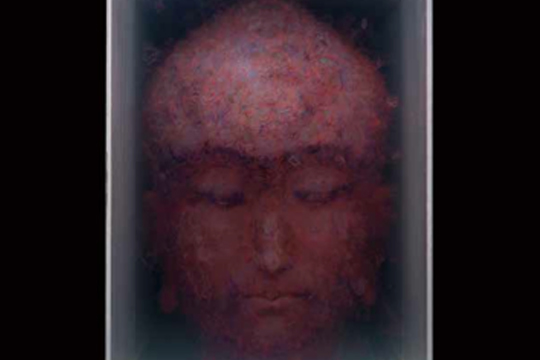XIA XIAOWAN: THE CREATION OF “TRUTH”
| May 10, 2013 | Post In LEAP 19

OVER THE PAST 30 years, Xia Xiaowan has painted countless images that are better described as deities, devils, or souls than as people. These images seem like those of gods in temples, vivid and lifelike, but nothing like in the natural world. In fact, in the 1980s and 90s, Xia studied the colors and brushwork of antique religious masterpieces. In his paintings, he reproduces these historical visual styles. A close look at the results reveals the artist’s intention of approaching and creating a “noumenal” world (for a time, he described his figurative work as “creating people”).
Around 2003, Xia Xiaowan began experimenting with “spatial paintings.” He paints slices of images on panes of clear glass that, viewed simultaneously in a horizontal stack, create a three-dimensional effect impossible to achieve on a single plane. He uses thin pigments that permeate through the layers of glass, and the resulting images, lit from above, seem as if they are suspended midair. Under white light, the figures within these artworks float like living creatures adrift in formalin. Xia pays little heed to the conceptual discourse of painting. His strength lies in his ability to use mature techniques to depict objects with a mystical temperament. The unique creativity of both his two-dimensional paintings and his spatial paintings lies in his revival of religious motifs. An important function of religious paintings is to stir the emotions of people in religious venues, in order to foster pious and moral conduct. This function is achieved through the two-dimensional simulation of reality. The techniques of realist painting have been perfected over the long course of art history, but these techniques can only achieve a superficial reality. They cannot transform appearance into essence and give genuine life to an image. Thus, prior to the point at which people ceased to believe that art has an ultimate goal, art fell short, only to change paths and move forward in a different direction. Xia Xiaowan’s savagely romantic spatial paintings return to that old path. Xia attempts to do what the old masters never could: use brushstrokes to create an object. In fact, the verisimilitude of his spatial paintings imbues them with a more sensuous impulse than his two-dimensional works. But the image disappears if the panes are viewed separately, leaving nothing behind but the fragments of the figure and its empty core. The distinction between a virtual image and a real object is indeed narrow, but it remains as insurmountable as the gulf between Kant’s noumenal and phenomenal worlds.
In his “Head Series,” Xia Xiaowan arranges human images similar to those of Correggio style (1489-1534) across different layers of glass. When a dozen or so panes are viewed in succession, countless images seem to fold together in space, creating a complete, three-dimensional image of a head. However, if one only looks at the individual sheets of glass, the lines and dots dissolve, leaving one lively image after another. These individual images are like an ineffectual retort, exposing Xia’s spatial painting as ultimately nothing more than inanimate illusion, adrift in the apprehension of lost belief. (Translated by Daniel Nieh)


